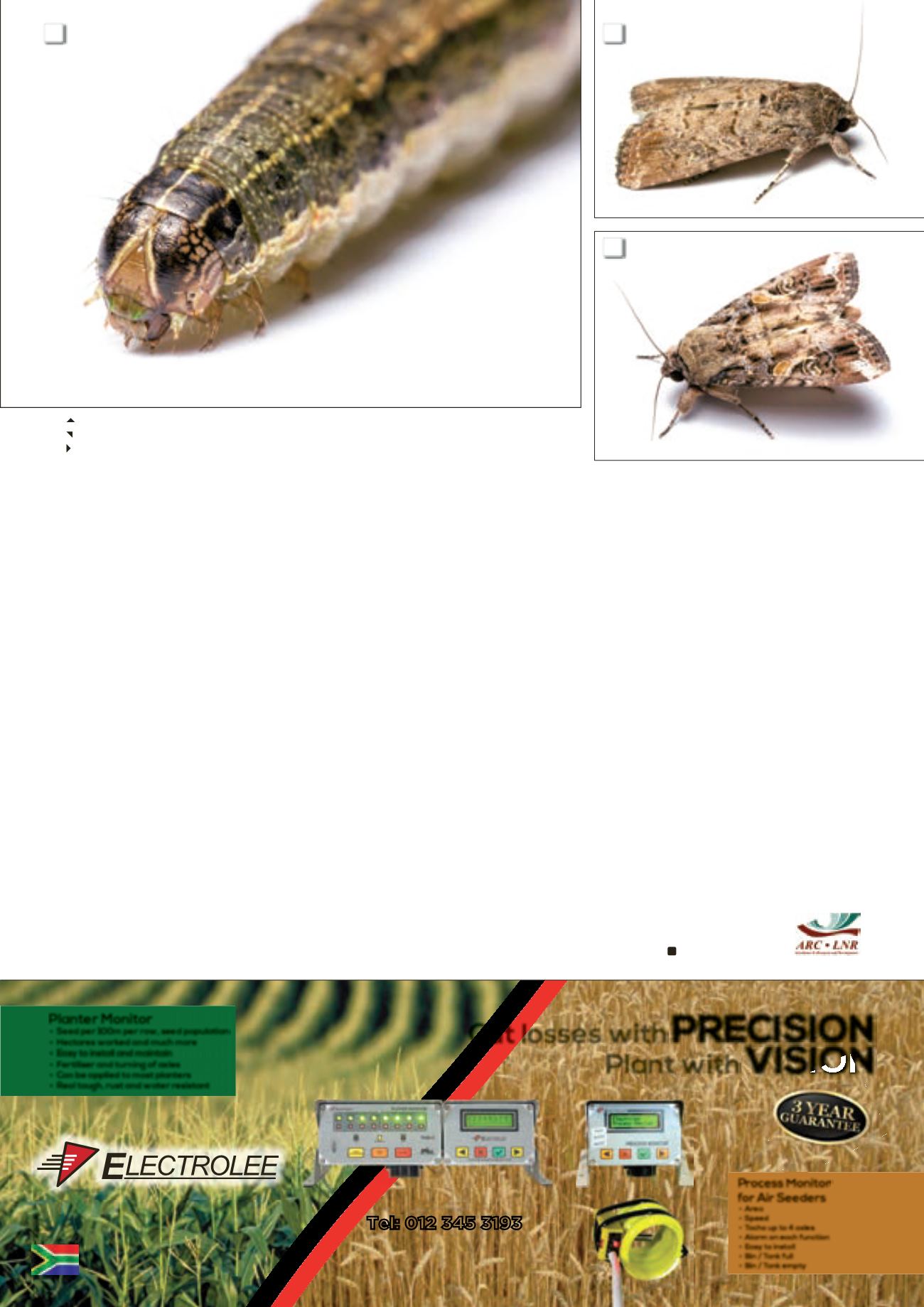

Cut losses with
PRECISION
Plant with
VISION
Process Monitor
for Air Seeders
Area
Speed
Tacho up to 4 axles
Alarm on each function
Easy to install
Bin / Tank full
Bin / Tank empty
Proudly Made
in South Africa
Tel: 012 345 3193
Fax: 012 345 6763
Web:
www.electrolee.co.zaEmail:
info@electrolee.co.zaSales:
sales@electrolee.co.zaPlanter Monitor
Seed per 100m per row, seed population
Hectares worked and much more
Easy to install and maintain
Fertiliser and turning of axles
Can be applied to most planters
Real tough, rust and water resistant
can be ploughed in which larvae are caught and can then be covered
or controlled by chemical means.
The lesser armyworm occurs across the world and the larvae can
also migrate in masses, but it is not certain whether this phenom-
enon has been observed in South Africa. This species can occur in
two phases, namely a migration phase during which they have a
darker colour, or a solitary phase.
The solitary larvae are usually found in the whorl of maize seedlings
in a C-shaped, curled attitude. The larvae are green, with a green-
brown head, and grow to a size of only about 15 mm on maize. Al-
though the colour of older larvae in the migratory phase can vary
considerably, they usually have a dark colour.
The moth of the lesser armyworm is pale grey, with brown mark-
ings on the forewings. The hindwings are white, with dark veins. The
moths can lay up to 600 eggs in clusters of 30 to 100 on other plants,
but this is usually not the case on maize.
Such a large number of larvae seldom occur on maize, where they
usually occur singly. The larvae become pupae in pupal cases in the
soil and moths appear ten to twelve days later. This species seldom
reaches pest status on maize.
The fall armyworm that recently arrived in South Africa occurs
widely in North and South America. This pest feeds on a large vari-
ety of plants, but prefers grasses and grass crops. However, it can
also cause major damage to groundnuts, soybeans, cowpeas and
wheat. The larvae grow very quickly and eat large holes in leaves, or
even the entire leaf.
The larvae initially have a green colour, which changes to a green-
brown colour as they mature. The larva has a characteristic Y shape
(
Photo 4
) on the forehead. The larval stage can last between 16 and
30 days, depending on temperature and humidity.
The fully grown larva becomes a pupa in a pupal case in the soil.
The moth emerges after about a week and lays eggs on vegetation
around grass areas. The female moth (
Photo 5
) can be clearly distin-
guished from the male moth (
Photo 6
).
Producers should therefore look out for outbreaks of armyworm.
A good indication in the field is the flocking of birds in pasture,
where they feed on the larvae. If any such outbreaks occur, clear
photographs should be taken and the ARC-Grain Crops Institute
(ARC-GCI) should be informed. As soon as an outbreak is reported,
the species will be identified.
For more information or to report outbreaks, call Annemie Erasmus
on 018 299 6113 or
ErasmusA@arc.agric.za .We would like to thank Matt Bertone (North Carolina
State University) and Diedrich Visser (ARC-Roode-
plaat) for the outstanding photos.
4: Characteristic Y shape of fall armyworm.
Photo: Matt Bertone
5: Female moth of fall armyworm.
Photo: Matt Bertone
6: Male moth of fall armyworm.
Photo: Matt Bertone
4
5
6

















